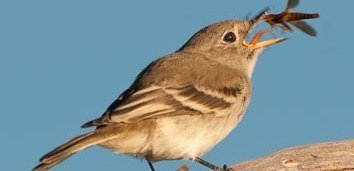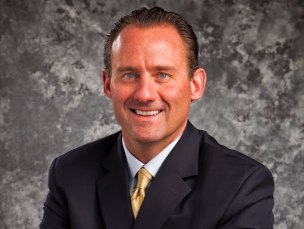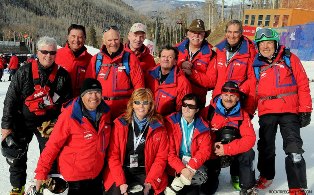Federal willow flycatcher recovery plan shifts focus away from merely maintaining status quo
A proposal made this month to increase critical habitat for the Southwestern willow flycatcher represents a shift in philosophy at the U.S. Fish and Wildlife Service, which instead of merely trying to maintain populations of endangered species is now aiming to boost them.
"The thing that really sets this proposal apart is we've set recovery as our vision for this critical habitat designation," agency spokesman Jeff Humphrey told the Associated Press. "In the past, the Fish and Wildlife Service and everyone has really struggled with the role of critical habitat and the courts have increasingly made it clear that recovery should be our vision, not just conservation at a static point."
The agency has identified 2,090 stream miles in Colorado, Arizona, California, Nevada, New Mexico and Utah where the birds nest and rear their chicks. The proposal is the result of a settlement the Fish and Wildlife Service reached with the Center for Biological Diversity, which challenged the federal agency's decision in 2005 to set aside less than half that amount of habitat for the willow flycatcher.
But game-changing litigation for environmental causes is under attack by dozens of Republican congressmen and scores of livestock and big-ag groups who want to limit the amount of money citizens, small businesses and nonprofits can recover when they successfully sue the U.S. government.
U.S. Reps. Cynthia Lummis and John Barrasso, both of Wyoming, in May introduced the Government Litigation Savings Act, co-sponsored by Mike Coffman, Doug Lamborn and Scott Tipton of Colorado.
The bill would place strict limitations on the Equal Access to Justice Act, which former President Ronald Reagan signed into law in the 1980s, and contains a key provision that a person, business or nonprofit may not receive an award in fees and other expenses of more than $200,000 in a single adjudication, and for no more than three such cases in the same calendar year, unless an agency's hearing officer determines that a higher amount is required “to avoid severe and unjust harm to the prevailing party.”
Mike Senatore, vice president of conservation law for Defenders of Wildlife, issued a statement calling the bill “a clear attempt to silence those citizens, small businesses and nonprofit organizations that don't have the financial resources to take action on their own. And by specifically targeting environmental groups, the members of Congress who support this bill have shown their complete disregard for protecting America's wildlife heritage and natural resources for future generations.”
Criticism of environmental litigation, however, isn't limited to Republicans and big-ag groups.
Ray Ring, a columnist for High Country News, recently skewered the Center for Biological Diversity for its lawsuit strategy, arguing that decades of lawsuits designed to re-establish wolves in Montana, Idaho and Wyoming “caused a new surge in anti-wolf — and anti-environmentalist — anger.”
Ring advocated a honey-over-vinegar approach to environmental causes, much like that of a marriage counselor friend of his who he wrote is effective in finding common ground among competing interests.
Kieran Sucklin, the executive director of the Center for Biological Diversity, fired back this week, posting a comment on a High Country News story that trumpeted the willow flycatcher news.
“I may not play the feel-good role that Ray Ring's marriage counselor friend has mastered, but it turns out, I'm not a marriage counselor, I'm a conservationist,” Sucklin wrote. “Litigation plays a critical role in that work because it's an effective tool to protect habitats that are being harmed by political intervention thwarting habitat protection laws. And if the right lawsuit is filed at the right time, it can bring about national policy change as well. The southwestern willow flycatcher doesn't need a marriage counselor, it needs a lawyer.”
![]() 0 Comments on "Federal willow flycatcher recovery plan shifts focus away from merely maintaining status quo"
0 Comments on "Federal willow flycatcher recovery plan shifts focus away from merely maintaining status quo"
Be the first to comment below.



 Vail Town Council to weigh new plan to redevelop T...
Vail Town Council to weigh new plan to redevelop T...  All about indexes
All about indexes  Transforming your social security into a winning r...
Transforming your social security into a winning r...  Pass sales, real estate transactions, revenues inc...
Pass sales, real estate transactions, revenues inc...  Vail Valley native with passion for Biophilic inte...
Vail Valley native with passion for Biophilic inte...  Beaver Creek starts work on new summer activities
Beaver Creek starts work on new summer activities  Land Trust, ECO Trails, Vail Resorts team up to cl...
Land Trust, ECO Trails, Vail Resorts team up to cl...  EUROVISION named Host Broadcaster for 2015 World A...
EUROVISION named Host Broadcaster for 2015 World A...  Vail Resorts brings back Lindsey Vonn's 'School of...
Vail Resorts brings back Lindsey Vonn's 'School of...  Hundreds turn out for 2015 World Championships vol...
Hundreds turn out for 2015 World Championships vol...  Eagle County Senior Health Expo and 9th Annual Hea...
Eagle County Senior Health Expo and 9th Annual Hea...  Final race of Vail Mountain Trail Running Series s...
Final race of Vail Mountain Trail Running Series s...  Before you write your will ...
Before you write your will ...  2015 World Ski Championships volunteer recruitment...
2015 World Ski Championships volunteer recruitment...  Ascent Sotheby’s International Realty in Vail an...
Ascent Sotheby’s International Realty in Vail an...  CDOT outlines road closures for local stages of US...
CDOT outlines road closures for local stages of US...  Italian artist creates unique trophies for Vail, B...
Italian artist creates unique trophies for Vail, B...  Vail Recreation District once again hosting Jake W...
Vail Recreation District once again hosting Jake W... 

